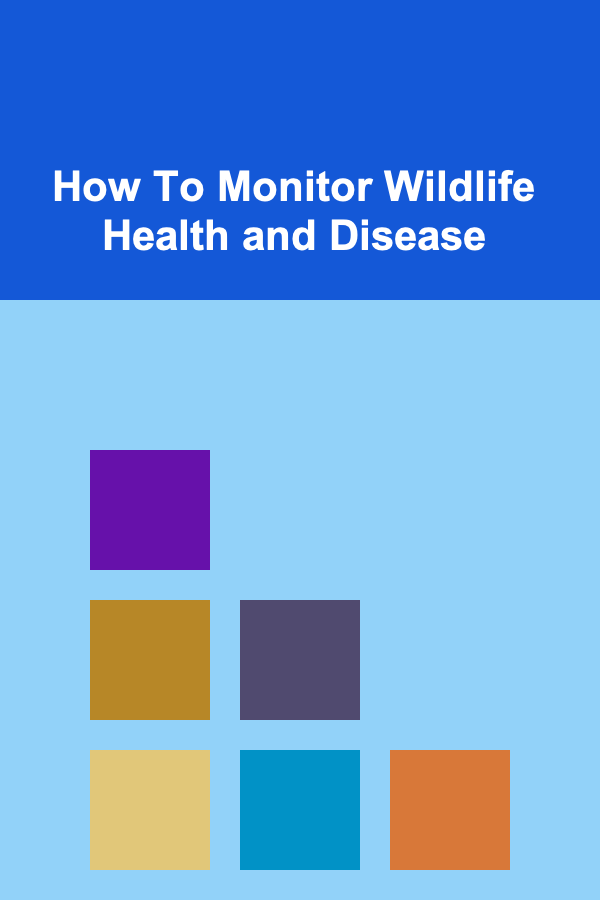
How To Monitor Wildlife Health and Disease
ebook include PDF & Audio bundle (Micro Guide)
$12.99$8.99
Limited Time Offer! Order within the next:

Wildlife health is an essential component of ecosystem health, as animals play crucial roles in maintaining biodiversity and the functioning of natural environments. The monitoring of wildlife health and disease is a growing field of study, crucial for ensuring the survival of species and ecosystems. Emerging diseases and the shifting environmental conditions brought about by climate change make monitoring wildlife health more vital than ever. This article explores the different methods used to monitor wildlife health and disease, the challenges involved, and the significance of such monitoring efforts in preserving wildlife and ecosystems.
Understanding Wildlife Health
Wildlife health refers to the physical, physiological, and behavioral state of animals in the wild. Healthy wildlife populations are essential to maintaining the balance of ecosystems, as they contribute to pollination, seed dispersal, and control of pests, among other ecological functions. Diseases in wildlife can threaten not only the health of individual species but also the broader biodiversity of an area, and can disrupt human livelihoods, particularly in sectors like agriculture and fisheries.
When monitoring wildlife health, it's essential to understand various factors that influence it, such as:
- Environmental Stressors: Changes in habitat, climate, pollution, and resource availability affect wildlife health.
- Disease Transmission: Many wildlife diseases are zoonotic, meaning they can spread to humans or domestic animals.
- Anthropogenic Factors: Human activities like deforestation, poaching, and land-use changes can increase disease risks by disrupting ecosystems.
Monitoring wildlife health involves a range of activities that detect early signs of disease outbreaks, track population health over time, and enable scientists to respond quickly to emerging threats.
Methods of Monitoring Wildlife Health and Disease
Monitoring wildlife health and disease is complex, requiring a multifaceted approach. Several techniques are used to assess animal populations' health, ranging from direct observation to advanced molecular diagnostics. Some of the most effective methods include:
1. Field Surveys and Observational Monitoring
Field surveys are a primary tool for monitoring wildlife health. These surveys involve the direct observation of animals in their natural habitat. Researchers track changes in animal behavior, population size, and physical condition over time to identify potential health concerns.
- Visual Observations: Field researchers often document any obvious signs of disease, such as unusual physical symptoms (e.g., lesions, limping, or abnormal behaviors).
- Behavioral Indicators: Changes in behavior, such as reduced movement, abnormal feeding patterns, or altered social interactions, can indicate health issues.
- Population Dynamics: Monitoring the age structure, sex ratios, and reproductive success within wildlife populations can provide insight into the overall health of a species.
2. Capture and Marking
Capture-recapture methods involve capturing wild animals, marking them (typically with radio collars, ear tags, or GPS trackers), and releasing them back into the wild. Researchers can then monitor their health over time, including assessing body condition, reproductive success, and movement patterns.
- Blood and Tissue Sampling: While the animals are captured, health assessments such as blood tests, tissue sampling, and parasite screening can be performed. These samples help detect infections or diseases and identify pathogens affecting wildlife populations.
- Longitudinal Studies: By marking animals and tracking their health over multiple years, researchers can observe long-term trends in disease outbreaks and their effects on the population.
3. Remote Sensing and Technology
Technological advances have transformed wildlife monitoring methods. Remote sensing tools such as drones, satellite imaging, and automated camera traps allow researchers to monitor wildlife populations and their habitats without disturbing them.
- Drone Surveillance: Drones can be used to observe large, remote wildlife populations and gather data on animal movement, health, and habitat use.
- Camera Traps: These automated systems capture images and videos of animals, which can be analyzed for signs of disease, physical condition, and behavior. Camera traps are especially useful for monitoring elusive or endangered species.
- GPS and Radio Telemetry: Using GPS collars or radio tags, researchers can track the movements of individual animals, allowing them to identify changes in behavior or habitat use that may indicate health problems.
4. Pathogen Monitoring and Disease Surveillance
One of the core components of wildlife health monitoring is the surveillance of infectious diseases. Pathogen monitoring involves the detection and identification of pathogens, such as viruses, bacteria, fungi, and parasites, that can impact wildlife health.
- Wildlife Disease Surveillance Networks: Many countries have established disease surveillance networks that monitor wildlife populations for emerging diseases. These networks collaborate with veterinarians, researchers, and governmental organizations to detect new diseases and track existing ones.
- Pathogen Screening: Samples from dead or sick animals are tested for pathogens. This can involve laboratory techniques such as polymerase chain reaction (PCR) testing, serological assays, and cultures. By identifying specific pathogens, researchers can better understand the spread of diseases.
- Molecular Epidemiology: Molecular techniques are increasingly used to map the spread of diseases within wildlife populations. By analyzing the genetic material of pathogens, scientists can track how diseases evolve and spread, which can inform conservation and management strategies.
5. Health and Disease Modelling
In addition to direct monitoring, researchers use mathematical models to predict and understand the spread of diseases in wildlife populations. These models are essential for understanding how diseases move through populations, how they impact individual species, and how they affect ecosystems.
- Epidemiological Models: By applying epidemiological principles to wildlife populations, researchers can predict disease outbreaks and assess their potential impact on populations. These models can help inform management decisions, such as when and where to implement disease control measures.
- Ecological Models: Ecological models integrate data on wildlife health with broader environmental variables, such as climate change and habitat degradation. These models can help predict how changes in the environment might affect disease transmission or the susceptibility of wildlife to certain diseases.
Challenges in Monitoring Wildlife Health and Disease
Monitoring wildlife health and disease comes with significant challenges. Some of the primary obstacles include:
1. Lack of Resources
Wildlife health monitoring often requires substantial funding, as it involves extensive fieldwork, advanced technology, and laboratory analysis. Resources are often limited, particularly in developing countries or in remote areas where wildlife is most vulnerable. Moreover, the coordination of international efforts to monitor cross-border wildlife diseases can be difficult, especially when resources are stretched thin.
2. Access to Remote and Protected Areas
Many of the most critical wildlife habitats are difficult to access due to their remote locations or legal protections. For example, endangered species might live in inaccessible forests, deserts, or mountain ranges, making it challenging to gather data without disturbing the animals. Even with technological advancements like drones, accessibility remains an issue in some areas.
3. Ethical Considerations
Capturing and marking wildlife raises ethical concerns, especially for endangered species or animals that are at risk of being stressed by human interactions. Research protocols must carefully consider the well-being of the animals and minimize harm during capture, handling, and sampling.
4. Data Interpretation and Integration
The vast amounts of data collected from various monitoring methods can be overwhelming to analyze. Integrating data from different sources, such as field observations, laboratory results, and ecological models, requires sophisticated analytical tools. Ensuring that the data is properly interpreted and communicated to stakeholders is also crucial for effective decision-making.
5. Climate Change and Emerging Diseases
Climate change is a growing concern, as it can alter disease dynamics by changing the range of pathogens and their vectors. For instance, warmer temperatures can expand the range of diseases such as West Nile virus or Lyme disease. Similarly, altered rainfall patterns can impact the prevalence of parasites like ticks and mosquitoes. Monitoring the impacts of climate change on wildlife health is an evolving challenge for conservationists.
The Importance of Monitoring Wildlife Health and Disease
Monitoring wildlife health and disease is crucial for several reasons:
1. Preventing Disease Outbreaks
Many wildlife diseases can be transmitted to domestic animals and humans, posing significant health risks. Early detection of diseases like avian influenza or Ebola can prevent outbreaks and mitigate their impact on human populations. Additionally, monitoring wildlife health can help protect biodiversity by preventing diseases from decimating vulnerable species.
2. Conservation Efforts
For conservationists, understanding the health of wildlife populations is essential to develop effective management strategies. Diseases can contribute to the decline of endangered species, and targeted health monitoring helps identify at-risk populations. Monitoring helps determine the best strategies for conserving these species, whether through habitat restoration, vaccination programs, or other intervention methods.
3. Ecosystem Health
Wildlife species are integral to the functioning of ecosystems, and their health directly impacts ecosystem stability. Monitoring wildlife health ensures that ecosystems continue to function optimally, preserving services like pollination, nutrient cycling, and carbon sequestration. Without healthy wildlife populations, ecosystems can deteriorate, leading to negative consequences for both wildlife and humans.
4. Public Awareness and Policy Development
The monitoring of wildlife health can raise public awareness about the importance of protecting wildlife and the environment. It also informs policy development, particularly in areas like wildlife management, habitat conservation, and public health. Governments, NGOs, and international organizations rely on health monitoring data to make informed decisions about biodiversity protection and disease management.
Conclusion
Monitoring wildlife health and disease is a vital aspect of conservation and public health, providing essential insights into the well-being of animal populations and the health of ecosystems. By employing a combination of observational studies, technology, pathogen surveillance, and ecological modeling, researchers can detect emerging threats and develop strategies to protect wildlife. Despite the challenges, the importance of this monitoring cannot be overstated, as it safeguards biodiversity, supports ecosystem health, and helps prevent zoonotic diseases from affecting humans. As the global community continues to grapple with the impacts of climate change and habitat loss, wildlife health monitoring will be a cornerstone of effective conservation and sustainable development efforts.

How To Choose the Best Sports Documentaries
Read More
How to Mix High-End and Budget-Friendly Decor for a Stylish Home
Read More
How to Protect Your Investments with Hedging Strategies
Read More
How to Save Space with Folding Doors and Partitions
Read More
How to Use Employee Benefits Enrollment Software to Streamline the Process
Read More
How to Secure Your Social Media Accounts: A Comprehensive Guide
Read MoreOther Products

How To Choose the Best Sports Documentaries
Read More
How to Mix High-End and Budget-Friendly Decor for a Stylish Home
Read More
How to Protect Your Investments with Hedging Strategies
Read More
How to Save Space with Folding Doors and Partitions
Read More
How to Use Employee Benefits Enrollment Software to Streamline the Process
Read More